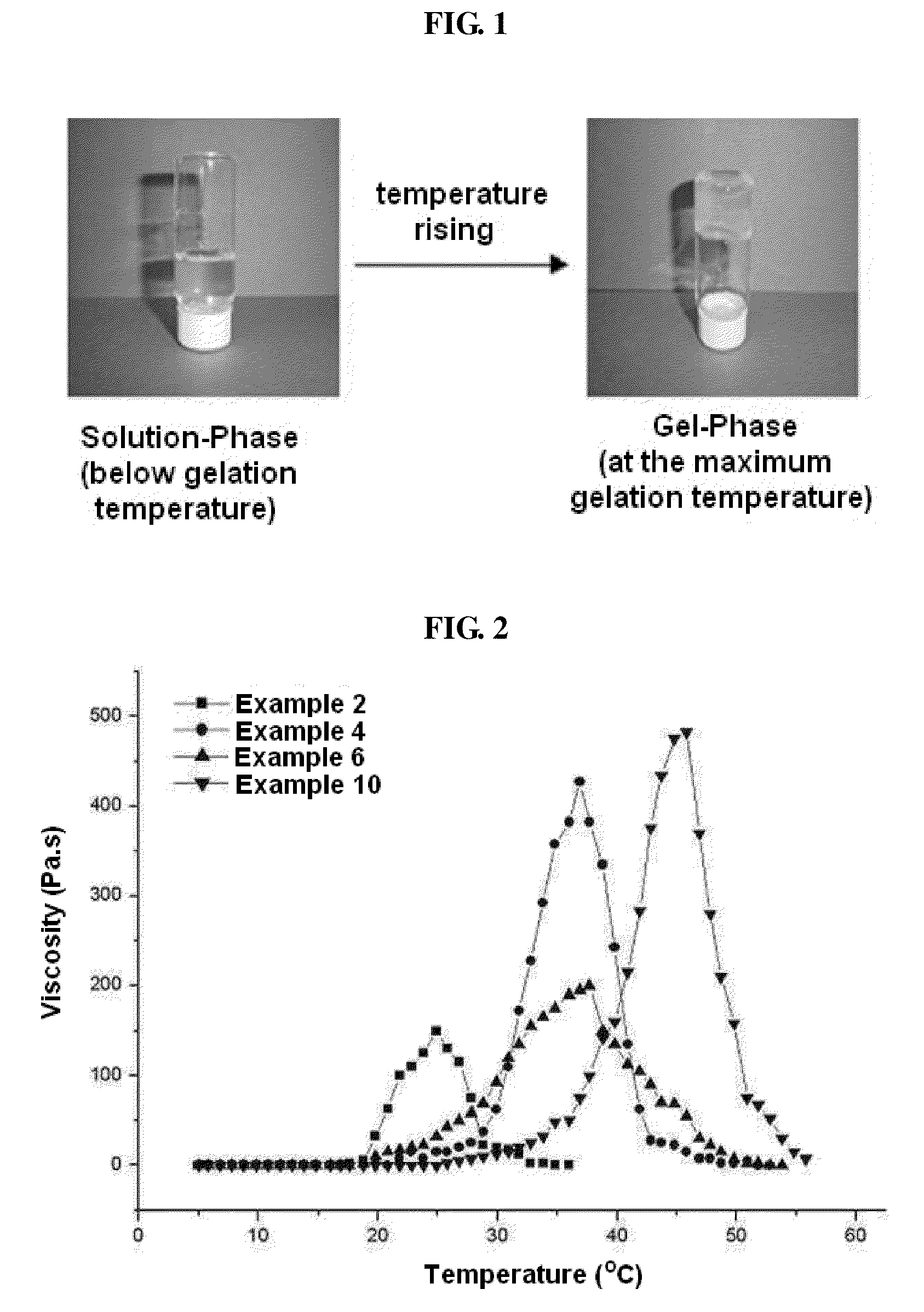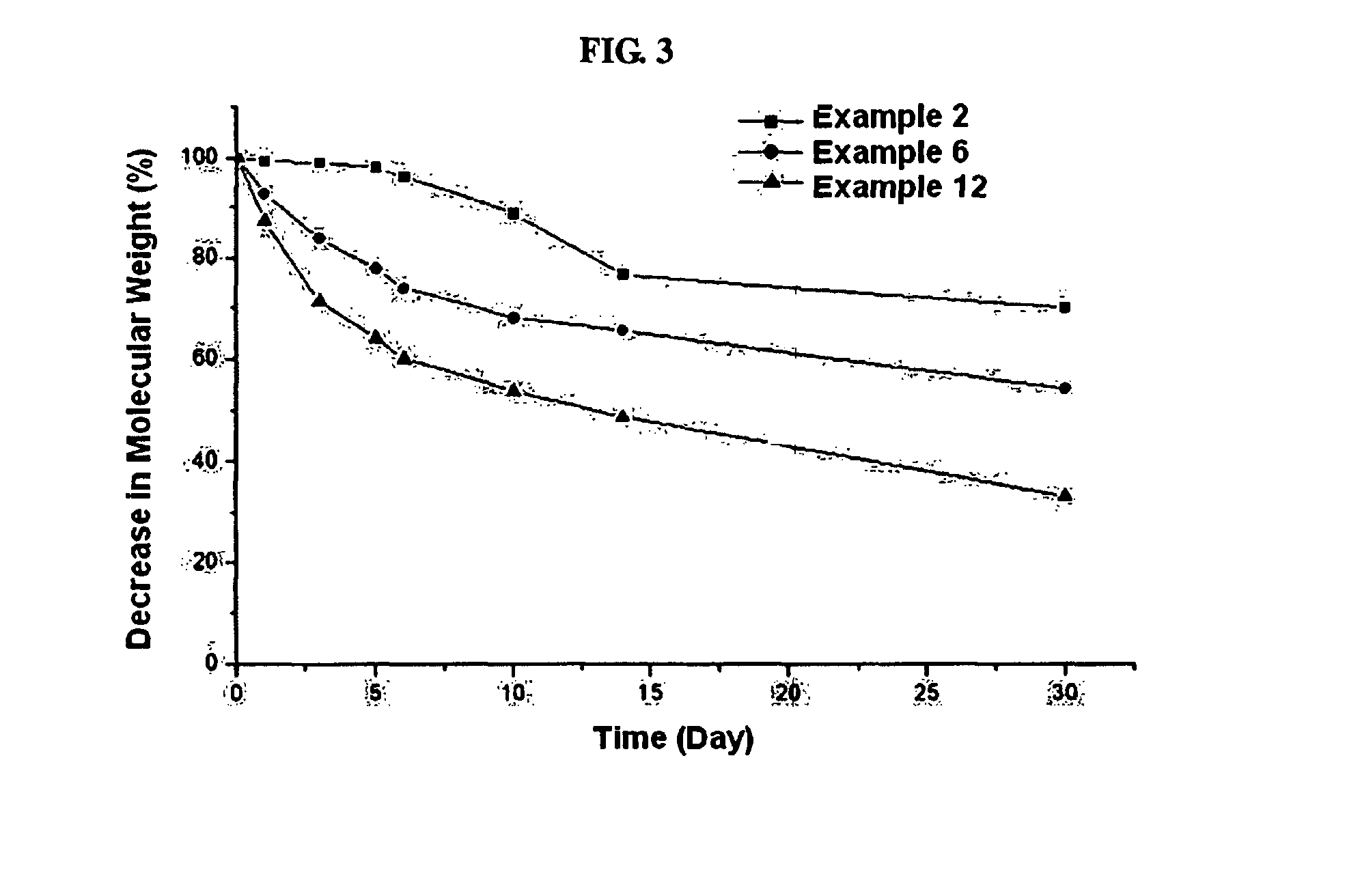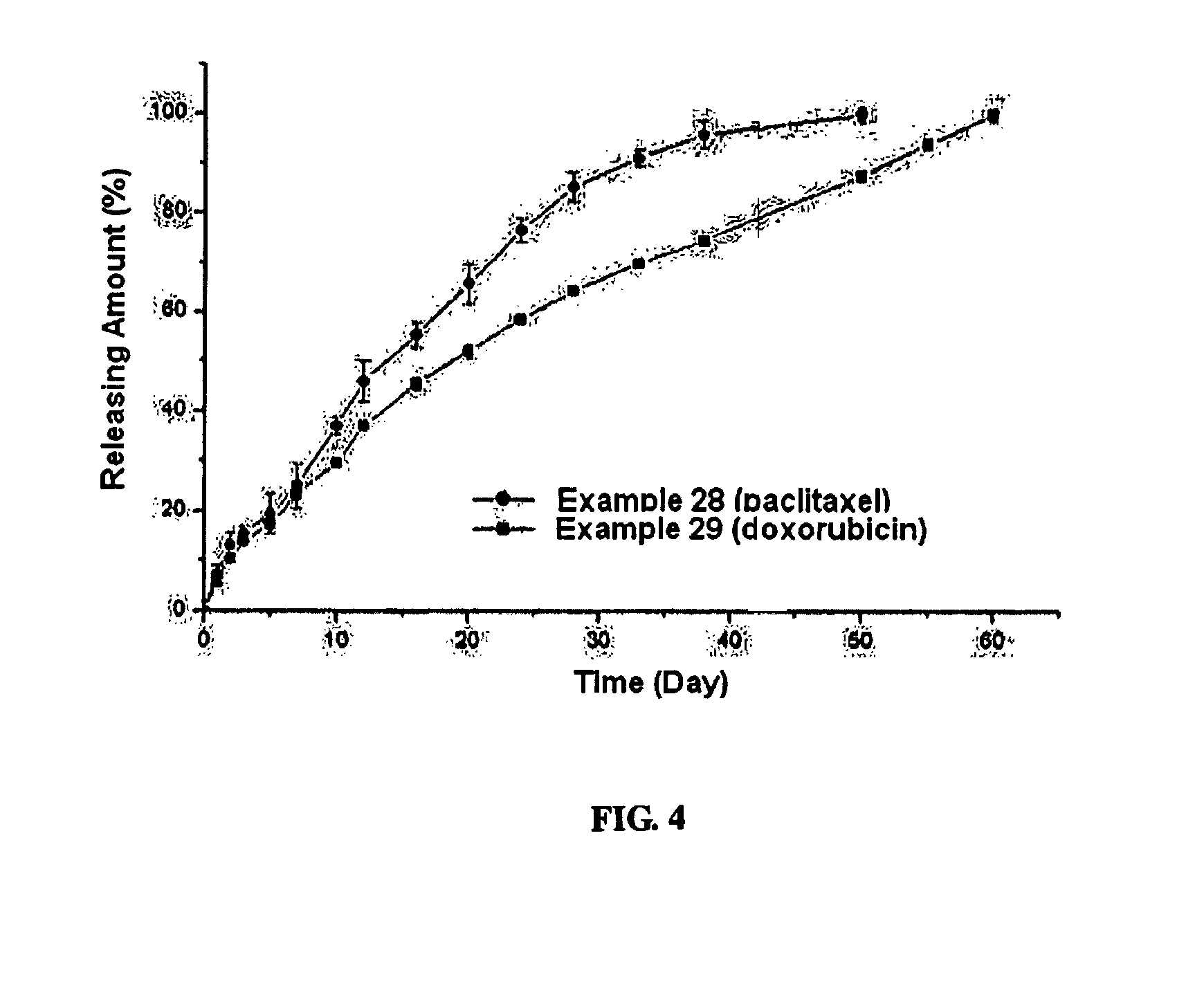Poly(organophosphazene) hydrogels for drug delivery, preparation method thereof and use thereof
a technology of poly(organophosphazene) and hydrogels, which is applied in the field of biodegradable and thermosensitive poly(organophosphazene) hydrogels for drug delivery, and the preparation method thereof, and can solve the problems of large amount (30% or more) of drugs to be released, inability to achieve sustained release of drugs, and inability to cytotoxic and non-biodegradable effects
- Summary
- Abstract
- Description
- Claims
- Application Information
AI Technical Summary
Benefits of technology
Problems solved by technology
Method used
Image
Examples
example 1
Preparation of poly[(phenylalanine ethyl-ester)(aminomethoxy polyethyleneglycol 350)(lysine ethyl-ester)phosphazene], [NP(PheOEt)1.03(AMPEG350)0.84(LysOEt)0.13]n
[0164]Poly(dichloro phosphazene) (2.00 g, 17.26 mmol) was dissolved in tetrahydrofuran (100 ml). Phenylalanine ethyl-ester hydrochloride (4.08 g, 17.78 mmol) and triethylamine (13.98 g, 69.04 mmol) were sequentially added thereto in a dry ice-acetone bath, and then the mixture was reacted at room temperature for 48 hours. A tetrahydrofuran solution (50 ml) in which triethylamine (13.98 g, 69.04 mmol) and aminomethoxy polyethylene glycol were dissolved and having a molecular weight of 350 (5.44 g, 15.53 mmol) was added to the obtained reaction solution, to perform a reaction at room temperature for 48 hours. Then, the obtained reaction solution was slowly dripped into a vessel containing a tetrahydrofuran solution (50 ml) in which lysine ethyl-ester hydrochloride (1.03 g, 4.49 mmol) and triethylamine (13.98 g, 69.04 mmol) wer...
example 2
Preparation of poly[(isoleucine ethyl-ester)(aminomethoxy polyethylene glycol 550)(lysine ethyl-ester)phosphazene], [NP(IleOEt)0.86(AMPEG550)0.85(LysOEt)0.29]n
[0178]The synthesis was conducted by the same method as in Example 1, except that poly(dichloro phosphazene) (2.00 g, 17.26 mmol), isoleucine ethyl-ester hydrochloride (1.51 g, 14.84 mmol), aminomethoxy polyethylene glycol having a molecular weight of 550 (8.07 g, 14.67 mmol), lysine ethyl-ester hydrochloride (1.92 g, 10.01 mmol), triethylamine (15.09 g, 74.55 mmol), and tetrahydrofuran (200 ml) were used, to obtain 6.95 g of the end product [NP(IleOEt)0.86(AMPEG550)0.85(LysOEt)0.29]n (yield 75%).
[0179]Empirical Formula: C30H68N8O14P
[0180]Elementary analysis data: C, 47.80; H, 9.20; N, 9.60
[0181]Theoretical value: C, 48.21; H, 8.97; N, 9.58
[0182]Hydrogen Nuclear Magnetic Resonance Spectrum (CDCl3, ppm):
[0183]δ 1.1˜1.3(b, —NHCH(CH(CH3)CH2CH3)OCH2CH3),
[0184]δ 1.3˜1.6(b, —NHCH(CH(CH3)CH2CH3)OCH2CH3),
[0185]δ 1.6˜1.9(b, —NHCH(CH(CH...
example 3
Preparation of poly[(phenylalanine ethyl ester)(ethyl-2-(O-glycyl)lactate)(aminomethoxy polyethyleneglycol 550)], [NP(PheOEt)1.10(GlyLacOEt)0.02(AMPEG550)0.88]n
[0193]The synthesis was conducted by the same method as in Example 1, except that poly(dichloro phosphazene) (2.00 g, 17.26 mmol), phenylalanine ethyl-ester hydrochloride (3.16 g, 18.99 mmol), ethyl-2-(O-glycyl)lactate ammonium oxalate (0.35 g, 0.87 mmol), aminomethoxy polyethylene glycol (molecular weight 550, 16.71 g, 30.38 mmol), triethylamine (12.06 g, 59.58 mmol), and tetrahydrofuran (200 ml) were used, to obtain 8.90 g of the end product [NP(IleOEt)1.10(GlyLacOEt)0.02(AMPEG550)0.88]n (yield 74%).
[0194]Empirical Formula: C29H70N5O14P
[0195]Elementary analysis data: C, 47.01; H, 9.38; N, 9.59
[0196]Theoretical value: C, 46.98; H, 8.97; N, 8.98
[0197]Hydrogen Nuclear Magnetic Resonance Spectrum (CDCl3, ppm):
[0198]δ 0.8˜1.2(b, —NHCH(CH(CH3)CH2CH3)OCH2CH3),
[0199]δ 1.3˜1.5(b, —NHCH(CH(CH3)CH2CH3)OCH2CH3, —NHCH2COOCH(CH3)COOCH2C...
PUM
| Property | Measurement | Unit |
|---|---|---|
| temperature | aaaaa | aaaaa |
| pressure | aaaaa | aaaaa |
| temperature | aaaaa | aaaaa |
Abstract
Description
Claims
Application Information
 Login to View More
Login to View More - R&D
- Intellectual Property
- Life Sciences
- Materials
- Tech Scout
- Unparalleled Data Quality
- Higher Quality Content
- 60% Fewer Hallucinations
Browse by: Latest US Patents, China's latest patents, Technical Efficacy Thesaurus, Application Domain, Technology Topic, Popular Technical Reports.
© 2025 PatSnap. All rights reserved.Legal|Privacy policy|Modern Slavery Act Transparency Statement|Sitemap|About US| Contact US: help@patsnap.com



